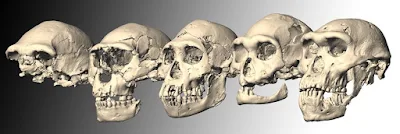Brazilian media has reported that today, Saturday July 6, 2019, Quaternary Science Reviews magazine will publish a paper authored by a Brazilian-Italian team who conducted a series of excavations on the Zarqa River in northern Jordan between 2013 and 2015. Their key discovery are stone tools dated 2.4 Million years old.
At the time that I published this post, I hadn't been able to find the article in Quaternary Science Reviews, but I will share what these news reports say (I am translating them more or less freely from Portuguese to English):
The fact that these stone tools are 2.4 Million years old is significant because it places them 500,000 years further back in time than the commonly accepted earliest date of hominid migration out of Africa.
The team unearthed some 450 pieces of stone of which at least 100 are really old. Images shown below depict these tools:
The age of these tools means that they predate Homo erectus and therefore, they are the work of the only hominid that existed at that time: Homo habilis.
Furthermore, it places H. habilis in the Middle East, that is, out of Africa and in Asia.
One of the paper's authors, Walter Neves, a Brazilian biologist, archaeologist and anthropolgist stated that "With our discoveries, we demonstrated that man left Africa some 500 thousand years earlier, and that the transition from Homo habilis to Homo erectus took place in the Caucasus and not in Africa".
Their discovery would, as Neves says "solve one of the biggest problems of paleonanthropology fo the last 20 years" by explaining the skulls found in Dmanisi, Georgia, in the Caucasus as belonging to H. habilis.
These five skulls, pictured below, had been originally assigned to a local branch of Homo ergaster, now they are considered as being Homo erectus and their age of 1.8 My makes this feasible, as it coincides more or less with the date of the supposed migration of Homo erectus out of Africa. However the size of the Dmanisi skulls was problematic: they were very different to each other and far smaller than Homo erectus skulls... they were more like Homo habilis skulls.
The Dmanisi remains data (from David Lordkipanidze et al., (2013). A Complete Skull from Dmanisi, Georgia, and the Evolutionary Biology of Early Homo. Science 18 October 2013. Vol. 342 no. 6156 pp. 326-331; doi: 10.1126/science.1238484):
- Similar to the "African" H. erectus (known as H. ergaster) but have smaller crania and therefore closer to H. habilis.
- Skull sizes from 546 to 730 cm3, compatible with theH. habilis' 509 to 687 cm3.
- Small bodied: 146 to 166 cm, 47 to 50 kg, similar to H. habilis but in the lower range of H. erectus.
Neves believes that they were Homo habilis, and that they are the forebearers of Homo erectus, who evolved in Asia out of H. Habilis stock.
He also suggests that this can explain the tiny Flores Island hominids and the old stone tools recently discovered in China, which are 2.1 Million years old, in line with what we wrote in our post on those tools (Hominins in China 2.1 Million years ago... pushing back the dates in Asia):
"And this is in China, surely the hominins who made those tools reached western Eurasia far earlier than the 2.12 My age assigned to those tools. Which may imply that they were not Homo erectus, maybe Homo habilis or even an australopithecine species! (maybe the ancestors of the primitive Flores island "Hobbit")."
The Flores - Homo habilis link was proposed by Debbie Arguea et al., (see my post First Asians were not Homo erectus revisited) in June 2017, and Neves' dates seems to support it.
We will update this post once the paper is published.
Patagonian Monsters - Cryptozoology, Myths & legends in Patagonia Copyright 2009-2019 by Austin Whittall ©





















Thank you, your article is very good
ReplyDeleteviagra jakarta
viagra asli jakarta
obat kuat jakarta
pil biru jakarta